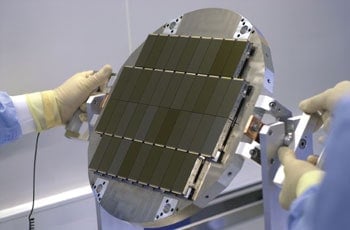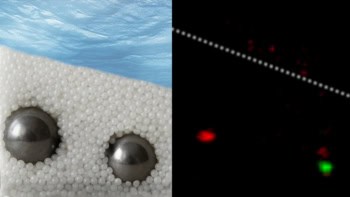A giant CCD sensor, in fact the largest ever deployed on a telescope, has captured its first images. The sensor, which is mounted on the Canada-France-Hawaii Telescope (CFHT) in Mauna Kea, Hawaii, uses an array of 40 individual CCD chips to take images containing 340 million pixels. In contrast, typical digital cameras on sale in the high street contain just 3 million pixels.

The CCD chips, made by e2v technologies of the UK, are a key part of the CFHT’s wide-field digital imager called MegaCam. The chips are mounted in an aray that has a central area made from four rows of nine CCDs and covers an area of 25 x 25 cm. This is equivalent to a 1 degree x 1 degree field of view on the sky, roughly the size of four full moons. Each CCD chip is sensitive to wavelengths from 300 to 1100 nm and contains 2048 x 4612 pixels.
The company says its custom-designed chip packaging makes the devices ideal for astronomy. “The packaging is designed to ensure that chips fit together with a minimal amount of light lost by falling down the cracks between the chips,” Paul Jordan from e2v said.
It took e2v 18 months to manufacture all 40 CCD chips, each of which has a surface flatness better than 10 microns. “This ensures all the light stays in focus without the need for any mechanical correction,” explained Jordan. “As the instrument is suspended at the primary focus of the telescope, this makes the system lighter, smaller and cheaper to construct in the long run.”
Before upgrading to the MegaCam, the CFHT used an imaging device based on 12 CCDs. “The new system has a much larger field of view and will allow astronomers to produce single images that contain much more information,” said Jordan. “Instead of seeing just a few stars in one image, astronomers can now see clusters of stars or extended galaxies.”
The MegaCam has only been in action since the beginning of April but has already acquired some spectacular images. With exposure times ranging from a few seconds to several minutes, the MegaCam can also acquire images much faster than other imaging methods, such as photographic plates.



